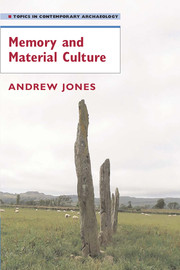Book contents
- Frontmatter
- Contents
- Preface
- 1 Memory and Material Culture?
- 2 From Memory to Commemoration
- 3 People, Time, and Remembrance
- 4 Improvising Culture
- 5 Continuous Houses, Perpetual Places: Commemoration and the Lives of Neolithic Houses
- 6 Culture, Citation, and Categorisation: Regionality in Late Neolithic Britain and Ireland
- 7 Chains of Memory: The Aesthetics of Memory in Bronze Age Britain
- 8 The Art of Memory: Memory, Inscription, and Place
- 9 Tracing the Past: Landscape, Lines, and Places
- 10 Coda
- References
- Index
2 - From Memory to Commemoration
Published online by Cambridge University Press: 07 December 2009
- Frontmatter
- Contents
- Preface
- 1 Memory and Material Culture?
- 2 From Memory to Commemoration
- 3 People, Time, and Remembrance
- 4 Improvising Culture
- 5 Continuous Houses, Perpetual Places: Commemoration and the Lives of Neolithic Houses
- 6 Culture, Citation, and Categorisation: Regionality in Late Neolithic Britain and Ireland
- 7 Chains of Memory: The Aesthetics of Memory in Bronze Age Britain
- 8 The Art of Memory: Memory, Inscription, and Place
- 9 Tracing the Past: Landscape, Lines, and Places
- 10 Coda
- References
- Index
Summary
In Chapter 1, I suggested that the idea of external symbolic storage was not helpful when considering the relationship between objects and memory. As an alternative I suggested that memory emerges from the mutual engagement between person and world. Yet the idea of memory as a storehouse is powerful. One of the prevailing models of the way memory is stored in the mind adopts the metaphor of depth to explain the way in which memories lie buried beneath strata of experience. This ‘poetics of depth’ (Wallace 2004) has attracted thinkers in a diversity of disciplines to adopt an archaeological metaphor for memory and the mind; we see discussion of layers of memories analogous to layers of soil or strata, to the excavation of artefacts as akin to the retrieval of memory, or, in Walter Benjamin's case: ‘genuine memory must therefore yield an image of the person who remembers, in the same way a good archaeological report not only informs us about the strata from which its findings originate but also gives an account of the strata which first had to be broken through’ (Benjamin 1999a, 576).
As Thomas (2004) has recently pointed out, one of the principal themes of modernist thought is to construct a sense of human interiority. Benjamin's characterisation, along with Freud's before it, provides a good example of just such a strand of modernist thought.
- Type
- Chapter
- Information
- Memory and Material Culture , pp. 27 - 46Publisher: Cambridge University PressPrint publication year: 2007

